2005 VOLKSWAGEN GOLF ESP
[x] Cancel search: ESPPage 206 of 444
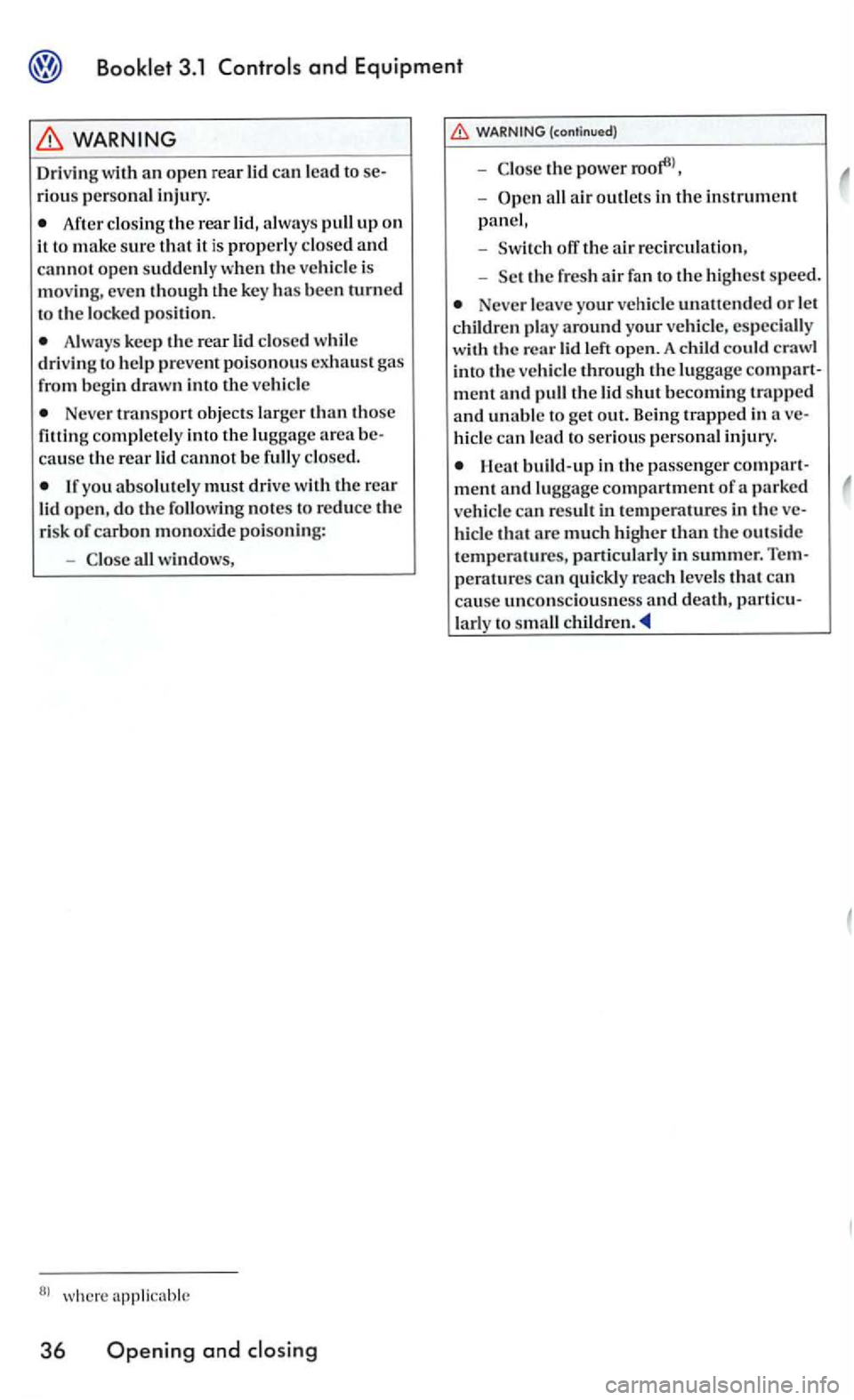
3.1
WARNING
Driving with an open rea r lid can lead to
rious personal injury.
After closing the rear lid , always pull up on
it to make sure that it is properly closed and cannot open suddenly when the ve hicl e is
moving, even though th e key been turned to the locked position .
Alway s keep the rea r lid closed whil e
driv ing to help prevent poisonou s ex haust gas
from begin drawn into the vehicle
Never transport objects larger than tho se
fitting completel y into the
cause the rear lid can not be fully closed.
you absolutel y must drive with the rear lid open, do the fo llowing notes to red uce the ri sk of carbo n monoxide poisoning:
-
all windows,
where applicable
36 Opening and
WARNING (continued)
-th e power
off the air recircu la tion,
-
th e fresh air fan to th e high est s p eed.
Never leave your veh icle unattended or le t
children play around you r ve hicle, especially
with the rear lid left open. A child could
m ent and pull the lid shut becoming trapped and unable to get out. Bein g trapp ed in hicl e can lead to serious personal injury.
ment and lug gage compartment of parked
ve hicl e result in tempera tu res in the hicl e that are much highe r than the o ut side
t emperatu res, particularly in summer. peratures can quickly reach levels that ca n
ca use unconsciou sn ess and death, larly to small
Page 207 of 444

and Equipment
-Take ho ld of one of the recesses
32 (arrow) in the interior trim of th e
rear
and pull the rear lid down.
the vehic le is locke d (anti-theft alarm system activated) and the re mote contro l key is used to unl ock the rea r lid only. th e rear lid is locke d im it is clo sed. All turn s ig n als flas h
bri efly to confirm that the rear lid has been
l ocked.
A dis pla y app e
ars in the instrument clu ster if th e
r ea r lid is no t properly clo sed.
WARNING
Always close th e rear lid properly to he lp avoid seriou s pers o n al injury.
WARN ING (co ntinu ed)
Neve r let anyone get in th e way of the edge s of the rear lid or its hinges when th e rear lid is
clo sin g.
Always make sure that the rear lid closes
properly when you close it so that it cannot open suddenly w hil e the ve hicle is moving.
Neve r leave your vehicle unattended or le t
c hild ren play around your vehicl e, especi ally
w ith the rear lid left open. A child could craw l
int o the vehicl e throu gh the lu ggage compart
m ent and pull the lid shut beco ming trapped and unable to get out. Bein g trapp ed in avehicle can lead to serious person al injury , espe
cially when it i s very hot or cold.
Neve r leave childr en , di sabled p ersons or a nyone w ho cannot help the m se lves in the ve
hicl e. The doors can be locked using there
mot e control key or th e ce ntr a l l ock ing button. Thi s could res ult in people being trapped in
th e ve hicl e.
Heat build-up in the passenger compart
m ent and lu ggage compartment of a parked veh icle can result in temperatures in the ve
hicle that are muc h hi gh er than th e outside temperatures, particularly in summer. Temperatures can qui ckly reach le ve ls that ca n cause unconsciousness and death, particu
larl y to s mall children.
Tip s
bookl et Tip s and Advice gency closing or
Opening and
Page 208 of 444
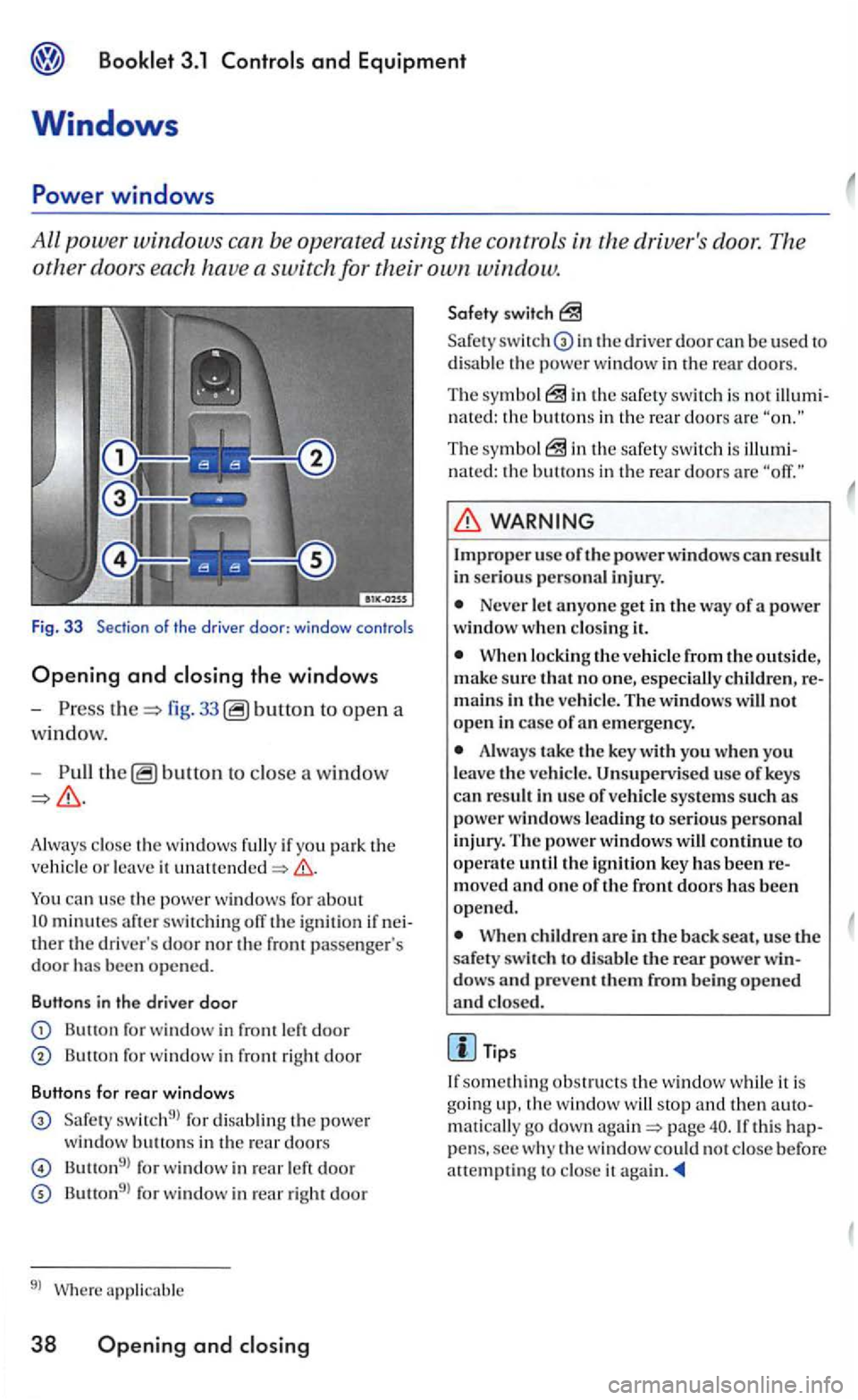
Booklet 3.1
the driv er's door. The
other doors each have a switch for their own window.
Fig. 3 3 Section of the driver door: windo w controls
Opening and closing the windows
-fig. 33 to open a
wi
ndow.
-b utto n to close a window
minutes after switch ing off the ign ition if ther the dri ver's door nor the front passe nger's door bee n opened.
Butt ons in the driver door
Button for window in front
Butto n for window in front right door
Butt ons fo r rear windows
switch9l for disa blin g th e powe r
window buttons in the rear doors
Button9l for window in left door
Button9l for window in rear right door
9l Where applicab le
38 Ope ning and closing
switch
in the driver door can be used to
d isab le the powe r w indow in the rear doors.
The sym bo l the safety switch is not n a ted : the buttons in the rea r doors are
The symbo l nated: the buttons in th e rea r doors are
Improper usc of the power window s can result in serious personal injury.
Never let a n yo ne get in th e way of a power window w hen clo sing it.
When locking the ve hicle fro m the outside, su re that no one, especially children, mains in th e ve hicle. The w indows will not open in case of emergency.
Alwa ys take the key with you wh en you
l eave the ve hicle. Unsupervised use of keys
ca n re sult in use o f vehicl e sys te m s such as power window s lead ing to serio us pe rsonal in jury. Th e powe r windows will continue to operate until the ignition key bee n
When children are in the back seat, use the
s afet y switch to disable the rear power dows and prevent them from being opened and closed.
Tip s
something obstructs the w indow while it is goin g up, the window will stop maticall y go down page pens, sec w hy the window could not close before att empting to close it
Page 210 of 444
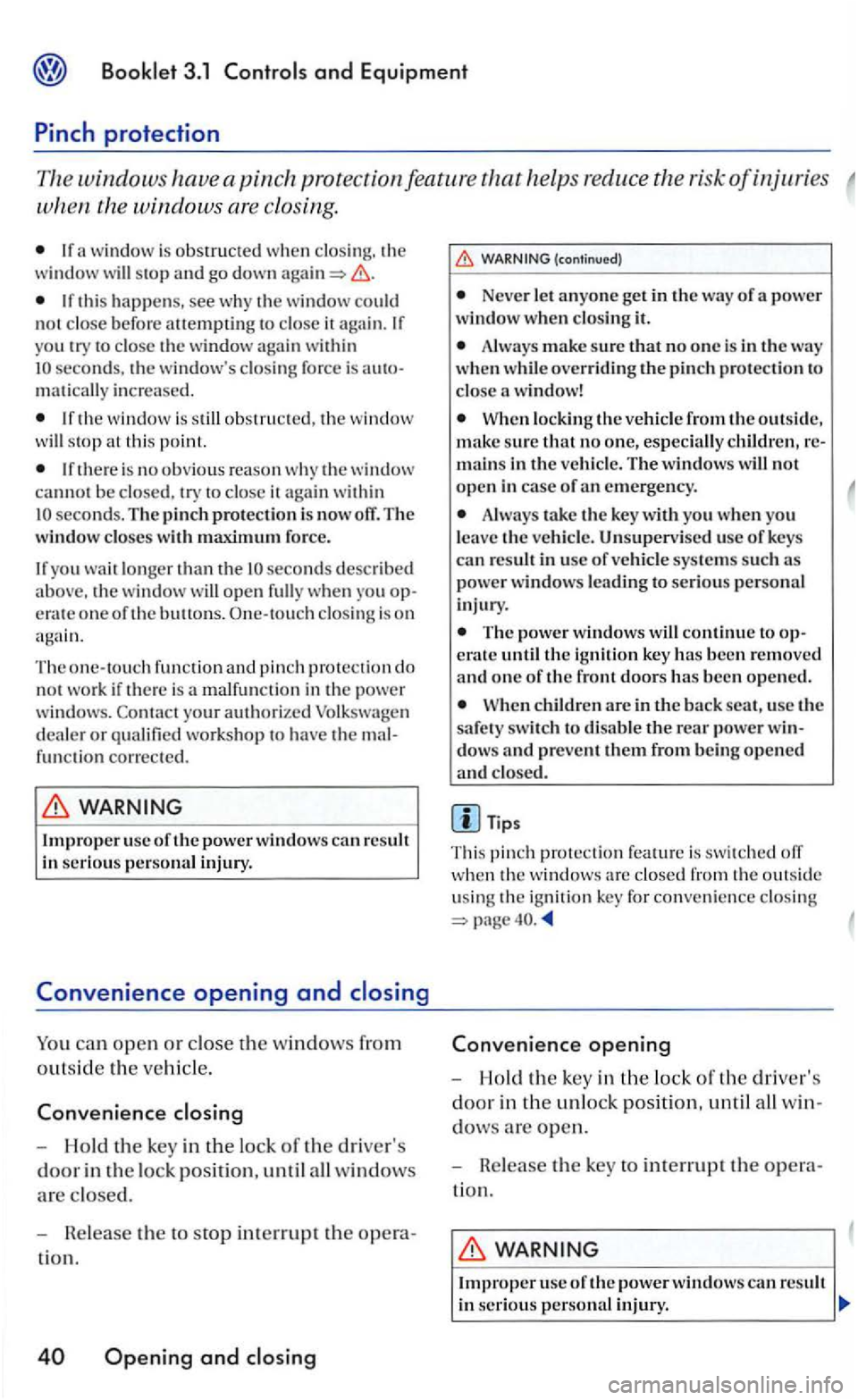
Booklet 3.1
If window is obstructed w hen clo sing. the window will stop a nd go down
If th is happens, see wh y the window co uld not close before attempting to close it a ga in . If
yo u try to close the window again within seconds. the window's clo sing force is m ati cally inc reased.
thi s po int.
If th ere is no obvious rea son why the cannot b e closed, try to close it again w ithin second s. Th e p inch pro tecti on i s now
If yo u wait longer than the seconds desc ribed above. the wi ndow will open fully when
The one-to uc h f unctio n and pinch protection d o
no t work if th e re is a m alfunction in the power
w indows. Contact your authorized Volkswagen dealer or qualified workshop to have the fun ction corrected.
WARNING
Improper use of the power windows can res ult in serious personal injury .
Convenience opening and
You can open or th e w indows from
o
uts ide the ve hicle.
closing
- Hold th e k
ey in
-Release the stop in terrupt the
WARNING (continu ed )
Neve r let anyo ne ge t in the of a power window w hen closi ng it.
make sure that no o ne is in the w hen window !
Whe n locki ng the ve hicl e from th e o uts ide, make sure that n o o ne, especi ally children , m ain s in the vehicle . T he windows will not open in case of em ergency.
ta ke the key with yo u when you leave the vehicle. Unsupervised use of keys can result in use of ve hicl e system s s uch as power windows leadin g to serious person al
in ju ry.
Th e power wi ndows will continue to
When chil dre n arc in t he back seat, use t11c safe ty sw itch to disabl e the rear power dows and prevent them fro m being opened and closed.
opening
- Hold th e ke y in th e lock of th e drive r's
door in th e unlock posi tio n, until all
dows are open.
- Hel
ease th e key to interrupt the
tion.
WARNING
Improper use of the power window s can res ult in seriou s personal injury.
Page 232 of 444

and Equipment
the backrest backwards and press
it back firmly until it latches. The re d mark
o n rhe release button should no lo nge r be
fig. 57 .
when foldin g the seat back up.
Folding the seat back up care lessly or without
c h ecki ng or ca n pin ch fin gers or limbs.
belts offer optimum protection only
w hen the sea t back is upri ght and belts arc
correc tly po sitioned on th e body.
Always make sure that the rear seat res t to whic h th e cente r rear safety belt is t ached is securely la tched whenever the rear center sa fety be lt is use d. If the backrest
62 Seats and storage
(con tinued)
is not secu re ly latched, the passenger move forward with the backrest during
sudde n braking , in a sudden maneuve r and espec ially in a c rash.
Never attach th e safe ty belt to the buckle
for another seat. Attaching the belt to the wro ng buckle ness and can cause serious pe rso nal injury.
A passenger who is not correctly restrain ed
ca n b e se riousl y injured by th e sa fety belt itself
when it move s the strong er parts of the body into sensitiv e areas like the abdomen.
Never le t th e safety belts beco me trapped
between the seat and the side of th e veh icle
when rai s in g the sea t ba cks. A trapped safety
b elt can be damaged so that it cannot help to
r e du ce the risk of injury in a crash.
Always make sure th at rear seat safety belts are in their proper position and able to be used
after the rear seat b ackres ts have been
Always make sure that the rear seat rests are sec urely latched after moving th em
b ack to the upright position. to properly latc h
it bac k. Loose
m ent in a crash and cause se rious injury .
A re d mark on the ba ckrest fig. 57 show s that the ba ckres t is not securely gaged. When the m arker is not visible the backrest is properly and sec urely latch ed. ways m ake sure the mark is not visibl e after raising the backre sts to the upright
Page 236 of 444
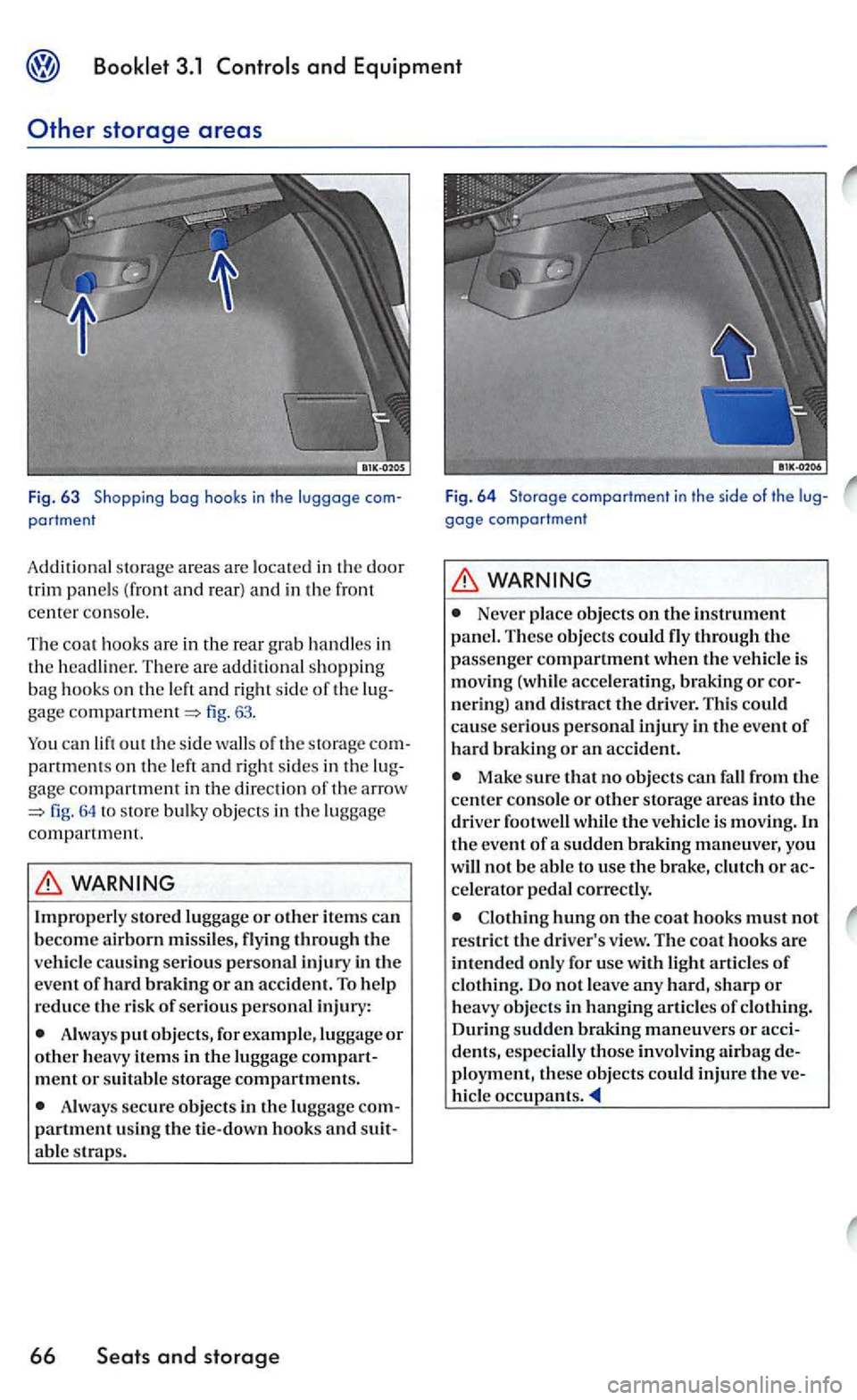
and Equipment
Other storage areas
Fig. 63 Shopping bog hooks in the luggage portment
Additiona l s torage areas are located in the door
trim panel s (f ront and rear ) and in the front
center console.
The coat hooks are
in the rear grab hand le s in th e There are add itional shopping
bag hook s on the and right side of the fig. 63.
out the s ide of the storage partm ent s on the and right sides in the
fig. 64 store bulky objects in the luggage
com partm ent.
Always put objects, for example, lug gage or other heavy items in the luggag e compartment or suitabl e storage compartments.
Always secure objects in the lu ggage partment using the tie-down hooks and able straps.
66
gage comportment
Never place objects on the instrument
panel. These objects could fly through the
passeng er compartm ent when th e is mov ing (w hile acce lerating, braking or n ering) and
Make sure that no objects fall from the cente r console o r other sto rage areas into the
dri ver footwell while the is m ov ing. In the event of a sudden brakin g maneuver, you
w ill not be able to usc tl1e brake,
hung on tl1e coat hooks must not rest rict the dri ver's view . The coat hooks arc intended only for usc with light of
of During sudden braking maneuvers or acci-
d e nts, especially those inv olv in g airbag de
ployment , these objects could inj ure the ve-occupants.
Page 244 of 444
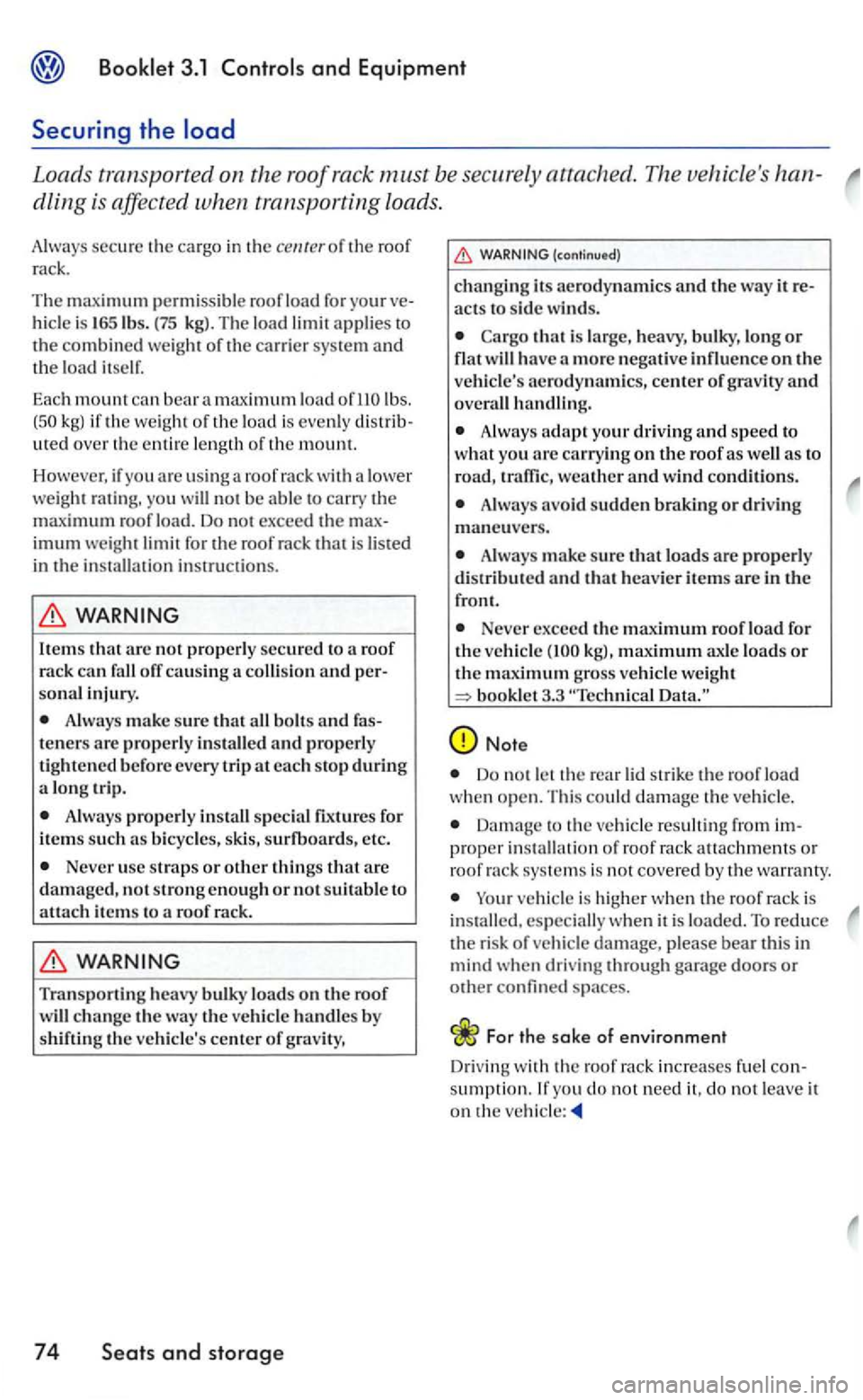
Booklet 3.1 Control s and Equipment
Securing the
Loads transported on the roof rack must be attached. The vehicle's han
dling is affec ted when transporting loads .
Always secure the cargo in th e center of the roof
rack.
Th e maximum permi
ssibl e roof load for your ve
hicle is 165 lb s. (75 kg). The load limit applies to th e combined weig ht of the carrier sys te m a nd
t h e load itse lf.
Each m ou nt can bea r a max im um loa d lbs.
imum weig ht limit for the roof rack
causing
A lw ays make sure that all and fas
t e n ers are pro perl y in stalle d and properl y
ti ght en ed befo re eve ry trip at e ac h sto p during
a long trip.
A lw ays properl y install s p ecial fixtures fo r items su ch a s bi cy cles, skis, surfboard s, etc.
Never use straps o r other things that are
d am age d, not stro n g e nough or n ot s uit able to
a tt ac h item s to a roof rack .
Transporting heavy bulky loads on the roo f
will change the way the ve hicle handles by
s hifting th e ve hicle's center or grav ity,
74 and storage
WARNING (continued )
changing its aerodynamics and th e way it reacts to sid e winds.
th at i s large, heavy , b ulky, lo n g or
Alw ays adapt your drivin g and sp eed to
w ha t yo u a rc carrying on th e roof as as to
road, t raffic, weath er a nd wind conditi ons.
Alwa ys avoid sudden brakin g or driving maneu ve rs .
A lwa ys make sure that loads arc p roperl y
dis tr ibuted and tha t heavier items are in the fro nt .
Never exceed th e maximum roofload for th e ve hicle kg). maximum axle loads or th e maximum gross vehic le weig ht booklet3.3
Note
Do n ot le t the rear lid strike the roof load
w hen open . This co uld damage the vehicle .
Damage to the vehicle resulting from im-
proper i n stallation o r roof rack attachments or
roof rack syste ms is no t covered b y th e warranty.
Your ve hicle is hig her when th e roof rack is
i n stalled, especially when it is loaded. To reduce the ris k or ve hicle damage, please bea r this in
min d when driv ing through garage doors or o ther confined spaces .
For the sa ke of envir o nment
Driv ing w ith
the roof rack increases fu e l consumption. you do not n eed it, do not leave it on the
Page 260 of 444
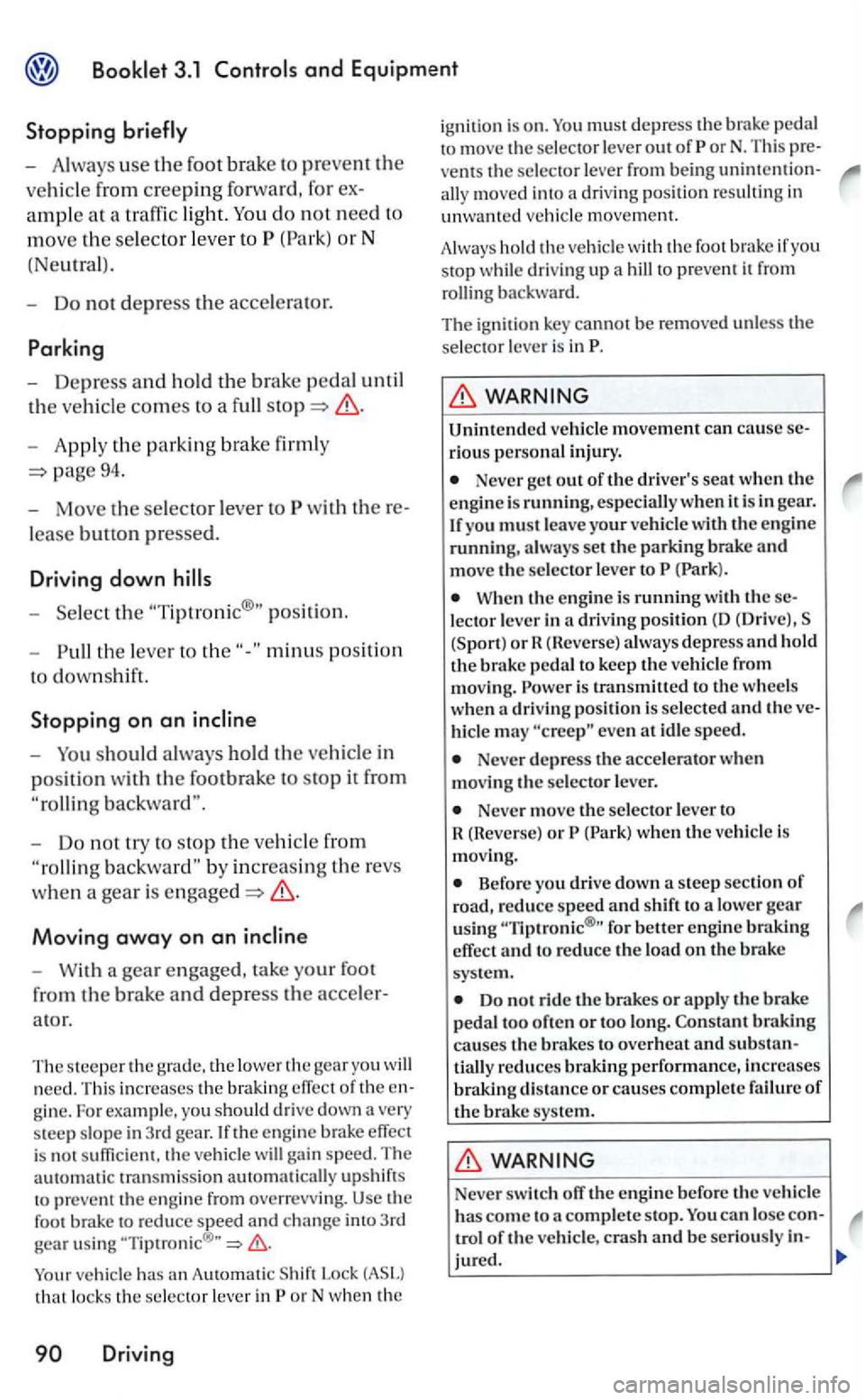
and Equipment
Stopping
-Alw ays use the foot brake to prevent the
vehicle from creeping forward , for
do not need to
move the selector leve r to (Park) or N
(Ne
utra l).
- Do not depress the accele rator.
Parking
- Depress and hold the brake pedal until
the vehicl e comes to a
- App ly the parking brake firmly
94.
- Mo ve th e
selector lever with
lease butto n pressed.
Driving dow n
-the position.
-
the lever to
-
- Do not try to stop the veh icle from
by increa sing the revs
w hen a
gear is
Moving a way on an
- W ith a gear engaged, tak e your foo t
f r o m
the brake and depress the
ator.
Th e stee per the grade, the lower the you will need. This increases the brakin g gine. For examp le, yo u sh ould drive down a very
s teep slop e in 3rd gear.lfthe engine brake is not s uffi cient. the vehicl e will gain spe ed . Th e tran smis sion automati cally up shift s
t o preve nt the engin e from the
foot brake to reduce speed and ch a nge into 3rd gear usin g 'Tiptronic®"
vehicl e has Automatic Sh if t Loc k (ASI.l that locks the selec tor lever in
must depre ss the brake pedal
t o move the selec tor lever out or N. Thi s
ally moved into a driving positi on result ing in unwante d ve hicle movement.
A lw a
ys ho ld th e vehicle with the foot if you
s top while driv in g up a hill to preve nt it fro m
rollin g backwa rd.
T he ig niti on
key ca nnot be remo ved unless the
s el ec tor lever is in
rious personal injury .
Never get out of the dri ver's seat when th e engin e is running, especially when it is in gear. If yo u must leave your vehicl e with the engine running, always set the parking brake and move the se lec tor lever (Pa rk).
When the engine is running with (Dri ve). (Sport) orR (Ileve rse ) a lways depress hold the brake pedal to keep th e ve hicl e from
m ov ing. is trans m i!!ed to the w heels
w hen a driving pos ition is selected even at idle speed.
Never depress th e accelerator when moving the selecto r lever.
Never move the selector lever to
R (Reverse) or whe n the vehicle is
m ov ing.
Before you drive down a steep section of road, reduce speed and shift to a low er gear usin g for better engin e braking effect and to reduce the load on the brake
sys te m.
Do not rid e the brakes or apply the brake pedal too often or too long. Constant braking
causes the brakes to overheat and tially reduces braking performance, increases braking dis tance or causes complete failu re of
the brake sys tem.
Never switch ofT the engine before the vehicle
h as come to complete s top. ca n lose con-trol of the ve hicle , crash and be serious ly in -
jured.